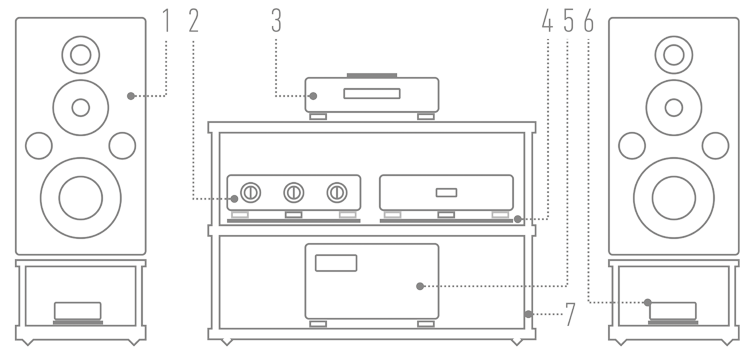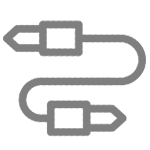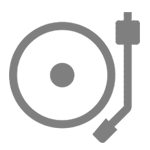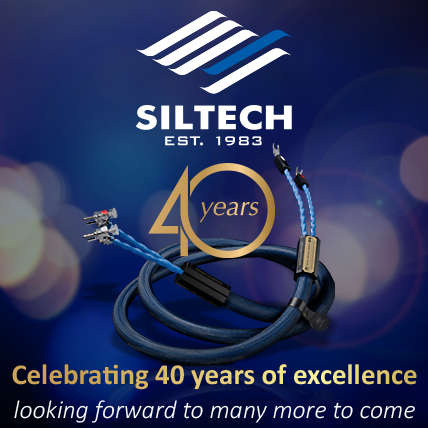|
INTEGRATED AMPLIFIER Ayon Audio
Manufacturer: AYON AUDIO |

|
Review
text WOJCIECH PACUŁA |

|
No 249 February 1, 2025 |
THE AYON AUDIO SCORPIO III INTEGRATED amplifier is the second one from the bottom of the price list of this manufacturer's amplifiers. And yet - one of the most important in its portfolio. Although above it you will find no less than six models, with the powerful Crossfire Evo-Delta limited edition model costing almost 100,000 PLN, it is the device we are testing that is something of a “workhorse” for Ayon. 
For, as Gerhard Hirt, owner and chief designer of Ayon said, the protoplast of the Scorpio series, Orion, and later → ORION II ˻ PL ˺, sold in the largest number in the history of this Austrian company. It was thanks to the money raised in this way that solutions from more expensive products could be transferred to cheaper products. In its make & finish it were the cheaper components that drew attention, particularly the black transformer shielding housings. The slightly more expensive devices were also successful. In an interview accompanying the test of the → SCORPIO II Gerhard said that already in this amplifier he returned to chrome finish details, mainly influenced by discussions with his American distributor. In the process, however, much of the circuitry was changed at that time, replacing the PCBs, upgrading the auto bias circuit, equipping it with a more powerful power supply and larger output transformers, allowing the unit to be used with KT88 and KT150 tubes. Keep in mind, however, that this is an amplifier originally designed to work with EL34 pentodes, the most classic amplifier tubes in the history of music. In its basic version it is available with just them, but - for an extra charge - you can also order KT88 flux tetrodes or even the mighty KT150. But... Have I mentioned to you before that I am a devoted EL34 fan? I'm sure I have, just take a look at the tests of the amps such as → LEBEN CS600X and → KONDO OVERTURE II. In my opinion, it is with it that the Scorpio III captures all its magic. ▌ Scorpio III THE TESTED AMPLIFIER features a classic Ayon look. Gerhard developed it years ago and is faithful to it. He makes adjustments to it from time to time adding either mottled knobs, or LEDs, or some other elements, but it's still the same design. In the new device we get a vintage-style VU meter for bias current, visually referring directly to the 1940s or 50s. Previously available in Ayon's more expensive products, it lands in these lower price regions for the first time. Other than that, the Scorpio III looks identical to its predecessor, the “II” model. The fact that it is a new model is indicated only by a stick-on name on the rear panel masking the older one. Components have changed, the auto-bias circuitry and other elements have also been redesigned, but in their basic form they are very similar products. The new Ayon Audio amplifier is a tube integrated amplifier with a solid-state power supply. The unit offers four RCA line inputs and, as an option, one digital, namely USB port. The latter accepts PCM signals up to 32 bits and 384 and DSD up to DSD256. A remote for volume control is also optional, and it features also a “mute” button. TUBES • All tubes, including the output tubes, operate in class A, without feedback. The input signal is amplified by 6Ж8 tube. This is the Russian equivalent of the 6SJ7, an octal pentode invented back in 1935. The one in the Ayon has a metal rather than glass bulb to protect the signal from interference. The units used in the Scorpio III were manufactured in the Soviet Union. Also from the USSR come the phase inverter tubes and the tubes that control the output tubes. These are dual octal 6H8C (6SN6) triodes. The output stage operates in a push-pull mode. In the basic version, its base are EL34 tubes, a pair per channel. Starting with the Scorpio II model, however, we can also choose other, more powerful KT88 or KT150 tubes. Each of them sounds different, but when choosing them the thing will be more about the output power, in the given series getting higher and higher. Thus, with EL34 we will get 2 x 38 watts, with KT88 we will get 2 x 43 watts, and with KT150 we will get as much as 2 x 50 watts. That is in the “pentode” mode. This is because the amplifier allows changing the operation mode of power tubes. As we know, pentodes can be “forced” to operate as if they were triodes. Here a small button on the rear panel serves this purpose, and the change is indicated by an LED on the front of the unit; by the way - all the LEDs, as well as the illuminated company logo, are red - what a relief. If you select triode mode, the maximum output power decreases. After all, pentodes, as well as beam tetrodes, were invented precisely because of their higher power output. Ayon then offers 25, 30 and 35 watts, respectively. AUTO-BIAS • Tube amplifiers are perceived by much of the audio community as difficult to use. Mainly because of problems with the tubes. In fact, most modern designs do not differ in any fundamental way from solid-state in terms of lifespan. Tubes need to be replaced, it's true, but quite rarely and it's a simple operation. This is helped by circuits such as those in the Scorpio III: microprocessor-controlled auto-bias and tube protection. The former automatically matches the tube supply voltages to the electric outlet’s voltage, and also corrects the bias current as the tubes age. The user can check their condition from time to time and read the indications on a small LED display on the rear panel. This circuit also provides a “soft” start, extending the lifespan of the tubes, as well as protecting them from overloading, so - again - extending their lifespan. The latter is also helped by an anodized non-magnetic chassis, hand-assembled from brushed aluminum, refined to better dissipate heat from the working tubes. 
The device is superbly made. Powerful dual power transformers that are flooded in their housings to minimize vibration, as well as a choke are part of an elaborate, multi-element power supply. The stages are coupled with polypropylene capacitors, the solid RCA jacks are gold-plated, and the speaker posts, with separate taps for 4 and 8 ohms, are made of copper (!) and sourced from the American company CMC. PRICING • The Scorpio II version with four EL34 tubes costs 15,900, with KT88 the prices goes up to 16,900 PLN, and with KT150 to 19,900 PLN. A small but massive metal remote control is available for an extra 200 PLN. The latter bears the same designation as the remote control on the Spheris III (RC-4A), but is different - there is no choice between amplifier and preamplifier control. For an optional board with USB input and DAC, we will pay 350 euros. ▌ SOUND HOW WE LISTENED • The Ayon Audio Scorpio III amplifier played in a HIGH FIDELITY reference system. It was compared to the reference two-box amplifier, namely the Ayon Audio Spheris III preamplifier and the Soulution 710 solid-state power amplifier. During the test, the unit stood on its three feet on the top carbon shelf of a Finite Elemente Pagode Edition Mk II rack. 
During listening, I used the Ayon Audio CD-35 HF Edition SACD player as the source. The signal between the player and amplifier was sent via Crystal Cable Absolute Dream RCA interconnect. The amplifier was powered by Harmonix X-DC350M2R Improved-Version cable, and the signal to the speakers was supplied by Crystal Cable Da Vinci speaker cable. The amplifier was driving Harbeth M40.1 speakers. I also took advantage of the option to select the output mode. However, the change has to be made with the unit turned off, and that means a longer time for the amplifier to shut down - that's how the tube protection circuitry works - and a second time after it is turned on - the same circuitry again is in operation at this time. So it is impossible to compare the sound of pentode and triode modes “on the fly”. Before testing, I turned on auto-bias setting mode, and the amplifier ran without a signal for about 1 hour. It was an AA/BB/AA, with known A and B. » RECORDINGS USED FOR THE TEST ⸜ a selection
⸜ ART BLAKEY & THE JAZZ MESSENGERS, Just Coolin’, Blue Note/Universal Music LLC (Japan) UCGQ-9027, SHM-SACD (2020). HAVE I ALREADY TOLD YOU that the EL34 tube is my favorite pentode for audio applications? Well, yeah, I've said that and more than once... I can't help it, though - I live in the audiophile world, I breathe its air, I speak its language. That's why, when I'm confronted with something that goes against and sometimes contrary to popular belief, I have to confront it. And that involves repeating, again and again and again, my version of the story. Dirk Sommer, editor-in-chief of → HIFISTATEMENT.net magazine regularly points out to me that I act a bit like a teacher in my tests. And that's because I repeat, repeat and repeat things. And also, I emphasize. But that, in my opinion, is the way to go. I need it myself when I learn about something new, when I read something more complex than two syllables. I know this is a good way to go. That's why I'll say something I've said several times before: EL34 rulez. And I am saying it once again listening to a particular device, not based on memories, records or obsessions. For the Ayon amplifier plays p-e-r-f-e-c-t-l-y. It is warm - hallelujah! It is also resolving - hallelujah once more! When the first sounds from ART BLAKEY and THE JAZZ MESSENGERS' album Just Coolin' flowed, I knew immediately, right here and now, that it was going to be a good experience. This is because its presentation does not focus on details. Maybe you had a moment to take a look at the editorial in this issue of “High Fidelity” - I hope you did :) And if not, I'll just add that it is about explaining the phenomenon of “dark” sound. And the Scorpio III offers exactly that. That is, it is set on a strong lower midrange. Which with the aforementioned CD came out beautifully, because Bobby Timmons' piano, set on the listening axis, was clear, dynamic and simply pretty. And yet it's usually the most poorly recorded instrument on Rudy Van Gelder's albums from his Hackensack studio days. Located in the dining room of his parents' house, it was small, so the instrument stood close to the wall, and the microphones were placed almost next to the strings. This extinguished dynamics and rolled off the bandwidth. And yet - it was still Rudy Van Gelder, wasn't it? Even so, you can hear that he was a genius; more about his recording techniques → HERE. And Ayon's amplifier allowed this to come out, recovering for us the sound of both this instrument and the others, including the drums. 
Contrary to the term I use to describe this kind of sound, i.e. “dark”, it has nothing to do with the dulling of the upper part of the band. It is absolutely and exactly the opposite. The tested amplifier plays an open, dynamic lively sound - Gerhard Hirt, the owner and designer, does not like muted playing. And the Scorpio III does not play like that. It is, if I may say so, a volcano of energy just before the eruption. For there is incredible energy in its delivery, but it is well-controlled. So when I heard the first guitar sounds ˻ 1 ˺ from Around the World, the opening track of the Californication album by RED HOT CHILI PEPPERS, I knew it was also a very versatile amplifier. You see, I am just after reading the biography of Rick Rubin, the producer of this album, so I understand a little better - or so it seems to me - the choices he made on his albums. And one of the most important ones is high compression. In truth, the album in question is often cited as a leading example of the so-called Loudness War. This consisted of maximal compression and boosting of bandwidth extremes to make a given track play as loudly as possible over the radio, usually car radios. It's a tragic time for sound, as was the time when everyone remastered albums focused on their “clarity.” But, as I say, when you know more, you also understand more. In this case, the compression is obvious and there is nothing to argue with. The effects Rubin achieved with it, however, are not about trying to outshout others on the radio. The Ayon Audio Scorpio III showed that it was all about maximum concentration of energy in small packets, so that they “explode” in front of the listener. The whole thing is dynamically quenched and almost flat. Yet the disc has incredible “power”. How do you reconcile this with compression? - Well, that's how I see it, precisely thanks to Rubin's efforts, who, using a despised technique, prepared an album that both the band and fans unanimously consider one of the band's most significant titles, perhaps even the most important one. The Austrian amplifier has shown this wonderfully. For it is extremely dynamic and extremely open. And yet - warm, and yet - dark. |
| Our albums ⸜ AQUAVOICE Flow Audio Cave ACD-008-2024 
FLOW IS THE FIRST album by Tadeusz Łuczejko, hiding under the name Aquavoice, released by the Audio Cave label. It is a follow-up to Waves, released in 2023. As the artist told us at the time, „recording the music took two years, mostly in autumn and winter, as I devote the warm months to organizing my exhibitions, as I am a visual artist by profession, concerts of my own and other artists', and bicycle tours near and far, as I am an avid cyclist”; more → HERE ˻ PL ˺. Both albums are linked by the participation of the same guests. Tadeusz said:
As a result, in the recordings we will hear India Czajkowska, Tadeusz Sudnik (electronic sounds), Wojciech Jachna and Mikołaj Trzaska. The recordings also use field recordings, and human voices, which he has so far treated as another instrument:

The album was created in Tadeusz's home studio. A fan of vinyl records, he records his music digitally. In doing so, he uses a DAW workstation called Audacity. It's an open-code based audio recorder and editor. The tracks were recorded by Tadeusz Luczyka in 16-bit resolution and at a sampling rate of 44.1 kHz. Guests recorded their tracks in other studios. In multi-track form, they were sent to Warsaw, to MARCIN BOCINSKI for mixing and mastering. He mastered Aquavoice's previous albums at his LEGATO MASTERING studio, but is known for many other projects. The sound of this album is extremely mature. Dense and deep, but also resolving. If we think that this is not a high-resolution signal and that the artist is recording music in “CD quality,” we will come to ask ourselves what the point is. And it's simply about good sound at the input, which is not entirely dependent on the resolution of the material. In its processing - yes, the more, the better, but the recording itself does not have to have a “hi-res” stamp. Think back to the Denon label albums, Brothers in Arms by Dire Straits or Ray of Light by Madonna - they were all recorded with the same parameters, 16/44.1; more → HERE. Flow is presented perfectly. Spatial, deep, with guest tracks usually located quite far in the mix, on a long reverb. Closer shown is Stasiuk, who sounds like he was recorded on an inexpensive recorder. His voice is dark and lacking in higher registers. these, however, are overlaid by the sound of the river. And the vocal itself has a high volume, is dark and deep. It's also wide, provided by sounds that ring out not so much “in the speakers,” but wide behind them. Generally speaking, it's a presentation that pulls away from the speakers. And it is superbly balanced tonally. 
After the dark Butterfly House with the author of Mury Hebronu as narrator, there comes the Flow, which builds bit higher in the range. Yes, still with low bass, but also with high energy in the midrange. But even then, we have a feeling of being immersed in this presentation. And when, as in Chrome, a low sound comes in, reminiscent of 1960s analog synthesizers, it's darker, denser, amazing. This is quiet music, almost contemplative at times, but with an inner energy that carries it. A musically wonderful album with a great sound! ● Sound quality: 10/10 Award: ˻ BIG RED BUTTON ˺. THAT'S WHAT HIGH END AUDIO SHOULD look/sound like - I'm thinking not only of the aforementioned album, but especially of the tested amplifier. With well-recorded albums we get dynamics, imaging, tonal depth and so on. On the other hand, with heavily “produced” ones, such as Californication, or the ˻ 2 ˺ Twenty Something from the Super album by the PET SHOP BOYS duo, rhythm. You see, each subsequent album played simply well cool with the Ayon, the music really turned me on. Even though it's an amplifier with a very resolving sound. 
Resolution, however, manifests itself in its entry into the depths of the presentation, not in its illumination. And if the production is a high end one, if the music is high end, and if the system around it is equally high end, then it doesn't matter how an album is recorded. Yes, Super was bit dull, somewhat closed in, without an open midrange and with a distorted treble, as was Californication. But it didn't matter. Because it SOUNDED WELL. The amplifier perfectly handles the bottom end, so that the presentation has momentum and power. This is not another “hi-fi” amplifier, but a device for music reproduction. And that's how it will be perceived with any album. But know, that when you play some top-notch recording, then you will relax, smile and - I hope - understand what I mean and why EL34 tubes are almost a fetish for me. In my case it was the MAYO NAKANO PIANO TRIO’ Miwaku, released by the Briphonic label on an Extreme Hard Glass CD-R, recorded from DSD master files. It was with it that I heard that the amplifier is not only dynamic, resolving and plays with strong bass, but also renders an excellent soundstage. It brings it closer to us, but without pulling up the back of it. This results is a deep panorama with widely spaced edges. But not being artificially blown up. In the Ayon's sound, it is possible to point out an emphasized bass sub-range responsible for the slam of the kick drum, and you can hear that this is a deliberate choice of the designer. It is thanks to it that the device plays with flair, with power, and the scale of phantom images is presented very well. This is not a warm, syrupy presentation, but one with proper power, energy, and drive. And yet, and yet the presentation is unequivocally warm. This is due both to the power pentodes used in this device, that’s what they do, but also to their application. Gerhard didn't fight them, didn't try to make KT tubes out of them, but simply let them play. 
TRIODE vs PENTODE • And yet we can still choose whether we listen to this amplifier in pentode or triode mode. When testing Ayon Audio amplifiers equipped with a triode/pentode switch, I almost always chose the latter position; in the case of KT tubes, it's a beaming tetrode, but it's accepted to treat it as a pentode. I did this against the widespread view in audio according to which “triode is the one and only right choice”. My experience says quite the opposite: triode - yes, but rarely. The same is also true this time. Scorpio III in the triode mode will give you a excellent saturated presentation with a close foreground. With soft bass, delicate, golden cymbals and high energy; energy is what you get in both modes. But it will also be a less transparent, less dynamically differentiated sound. As well as less selective. And the lower end of the band will be a bit “sluggish.” I have the impression that the choice of triode mode, not only in the amplifiers of this company, but in general, in many cases is dictated by the desire to mitigate the problems of pentode mode. Here such a support is not needed, because the Ayon plays in it perfectly. But it is not that what you get is a bad sound. Just different, more colored and “tweaked”. Even then, dynamics and density will be evident. Even from such a, rather brightly recorded, album as Blackout by the SCORPIONS. It's thirty-six minutes of great fun, which the tested amplifier will only turn up, showing crisp, biting, bright guitars spread by the sound engineer across the channels, as well as quite bright vocals in the middle. ▌ Summary THIS IS ONE OF COOLEST amplifiers from Ayon Audio, regardless of price. It goes without saying that the company's expensive products do everything better, but - this is my opinion - the Scorpio III has everything so perfectly put together that the jump in quality will not be so clear. For me, this kind of use of EL34 tubes is, along with Kondo and Leben amplifiers, exemplary. Ayon does what the Silver Luna model from Polish company Fezz Audio does in the lower price range. Its sound is dynamic, energetic, resolving, but also warm, as well as dark. In the sense that it is devoid of noisiness and brightness. The tonal balance of this device is shifted downwards, towards 400 Hz, so that all recordings gain mass. But if the music is recorded lightly, like the aforementioned Scorpions album, then it will be played as light. Only that - not “too” light. The device plays really well. It's the kind of product that you buy and forget about changes in this field. Then you have time to try various tubes - I'm thinking mainly of different types of EL34 - with anti-vibration feet, fuses, input caps, etc. There are plenty of possibilities. Because it's an amplifier around which you can build your system, in which every other component will be more expensive than it, even twice its price. But also with cheaper products it will not bring out the disadvantages, but only the advantages. 
Did I already say that I like EL34 tubes? I’m joking :) Ayon Audio Scorpio III utilizes their potential brilliantly. Award ˻ RED FINGERPRINT ˺ from us! ● ▌ Technical specifications (acc. to the manufacturer)
Frequency range: 10 Hz – 40 kHz (-3 dB) 
THIS TEST HAS BEEN DESIGNED ACCORDING TO THE GUIDELINES adopted by the Association of International Audiophile Publications, an international audio press association concerned with ethical and professional standards in our industry, of which HIGH FIDELITY is a founding member. More about the association and its constituent titles → HERE. |

|
Reference system 2025 |
|
 1) Loudspeakers: HARBETH M40.1 |REVIEW| 2) Line preamplifier: AYON AUDIO Spheris III Linestage |REVIEW| 3) Super Audio CD Player: AYON AUDIO CD-35 HF Edition No. 01/50 |REVIEW| 4) Stands (loudspeakers): ACOUSTIC REVIVE (custom) |ABOUT| 5) Power amplifier: SOULUTION 710 6) Loudspeaker filter: SPEC REAL-SOUND PROCESSOR RSP-AZ9EX (prototype) |REVIEW| 7) Hi-Fi rack: Hi-Fi rack: finite elemente MASTER REFERENCE PAGODE EDITION Mk II, more → HERE |
|

|
Cables Analog interconnect SACD Player - Line preamplifier: SILTECH Triple Crown (1 m) |ABOUT|» ANALOG INTERCONNECT Line preamplifier → Power amplifier: Siltech ROYAL SINLGE CROWN RCA; review → HERE Speaker cable: SILTECH Triple Crown (2.5 m) |ABOUT| |

|
AC Power Power cable | Mains Power Distribution Block - SACD Player: SILTECH Triple CrownPower (2 m) |ARTICLE| » POWER CABLE Mains Power Distribution Block → Line preamplifier: Acoustic Revive ABSOLUTE-POWER CORD, review → HERE » POWER CABLE Mains Power Distribution Block → Power amplifier: Acoustic Revive ABSOLUTE-POWER CORD, review → HERE Power cable | Power Receptacle - Mains Power Distribution Block: ACROLINK Mexcel 7N-PC9500 (2 m) |ARTICLE| Power Receptacle: Acoustic Revive RTP-4eu ULTIMATE |REVIEW| » ANTI-VIBRATION PLATFORM under Acoustic Revive RTP-4eu ULTIMATE: Graphite Audio CLASSIC 100 ULTRA, review → HERE Power Supply Conditioner: Acoustic Revive RPC-1 |REVIEW| Power Supply Conditioner: Acoustic Revive RAS-14 Triple-C |REVIEW| Passive filter EMI/RFI: VERICTUM Block |REVIEW| |

|
Anti-vibration Speaker stands: ACOUSTIC REVIVE (custom)Hi-Fi rack: finite elemente MASTER REFERENCE PAGODE EDITION Mk II, more → HERE Anti-vibration platforms: ACOUSTIC REVIVE RAF-48H |ARTICLE| » ANTI-VIBRATIONAL FEET: |

|
Analogue Phono preamplifier: Phono cartridges:
Clamp: PATHE WINGS Titanium PW-Ti 770 | Limited Edition Record mats:
|

|
Headphones » HEADPHONE AMPLIFIER: Leben CS-600X, review → HEREHeadphones: Headphone Cables: Forza AudioWorks NOIR HYBRID HPC |
main page | archive | contact | kts
© 2009 HighFidelity, design by PikselStudio,
projektowanie stron www: Indecity




















